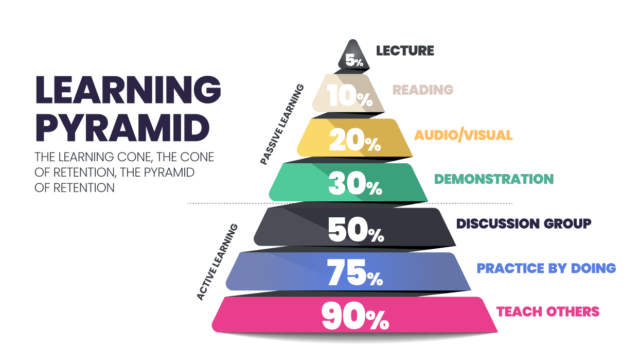Changing the Mindset to Active Learning
Changing the Mindset to Active Learning
According to a study by TalentLMS in 2022 one big problem in corporate training is a lack of motivation, “with 33% of employees finding it challenging to stay motivated to complete training.” (TalentLMS 2022)
So, how do we increase peoples’ motivation to complete corporate training programs and improve their learning outcome? According to TalentLMS “the majority of employees picked simulation and learning by doing”, when asked about their preferred format of training (TalentLMS 2022).
What does changing the mindset from formal learning towards active learning have to do with this? Why is active learning important when looking for corporate learning solutions? What is active learning and how does it differ from formal learning?
Let’s take a closer look at active learning and the benefits and importance for corporate training.
Formal learning and its downsides
Formal learning, also known as traditional learning, usually refers to a style of education that has been widely used for many years. Typically this refers to lecture-based learning, including i.e., textbook-based and exam-focused learning.
Formal learning is often instructor-led, the main source of information being the teacher, lecturer, or instructor. Learners “are passive recipients of knowledge from an expert”, as an article by the University of Minnesota states (University of Minnesota 2023).
Learners are expected to listen, take notes, rote and memorize information. This way of learning is often criticized for not fostering critical thinking, problem-solving skills, or creativity. It’s usually one-dimensional and allows only limited learner interaction or personalization.
As the learner is less in charge and less involved, the input often seems less meaningful. Consequently, the learner is less engaged and motivated, but rather bored and passive. The connection to real-world situations and a learner’s own interests and experiences is often missing.
To sum it up, formal learning may not provide the depth of learning or personal growth for your employees that an active learning approach provides.
Benefits of active learning
According to the University of Minnesota active learning “is any approach to instruction in which all students are asked to engage in the learning process.” (University of Minnesota 2023).
Watch this video about “active learning” to find out what the professors of the University of Minnesota have to say about it:
At schools and universities active learning has been a hot topic for quite a while already. Especially during the Covid-19 pandemic, educators were looking for new ways to engage learners (Aupperlee 2021).
An article by Cambridge university press points out that the focus of active learning is on “how” you learn something opposed to “what” you learn. While formal learning often comes with passively receiving information, active learning aims at challenging learners to “think hard”. Learners are more in charge, being responsible for their learning process themselves. (Cambridge University press)
However, active learning doesn’t mean the instructor isn’t needed anymore. On the contrary, “the teacher is still the director of their students’ learning. Skilful planning is very important.”, as stated by Cambridge University press. (Cambridge University press)
Carnegie Mellon University argues that “[…] research also found that effective active learning methods use not only hands-on and minds-on approaches, but also hearts-on, providing increased emotional and social support” (Aupperlee 2021).
This means the learner is not only physically more involved but also emotionally, affecting his motivation and satisfaction. Active learning promotes learners’ autonomy and ability to learn. Therefore, learners are more likely to become “lifelong learners”. (Cambridge University press)
The importance of changing the mindset to active learning
One shouldn’t underestimate the importance of the emotional side of learning. Learners’ feelings throughout the learning process impact their overall learning. A positive and meaningful learning experience will deepen the learning imprint.
Research has shown that active learning results in greater learner motivation and performance compared to formal learning (Aupperlee 2021).

As the above illustration shows, the more active learning methods are included in the learning process, the more likely input will also be stored in the brain. Thus, active learning increases learning success.
Therefore, changing the mindset of educators towards active learning is crucial because it will have a great impact on learners’ outcome. When it comes to corporate training, the outcome will eventually affect your employees’ career and your company’s productivity and value.
Active learning enables more flexible learning, responding better to individuals’ needs. Formal learning usually only allows few individuals to participate in lectures or seminars by asking something or responding to questions. Opposed to that, successfully adding active learning elements provides an opportunity for all learners to think, engage with course content or apply and practice learned skills. (University of Minnesota 2023)
Active learning is also something that many employees long for. TalentLMS found that a large number wishes for more ways of “learning by doing” in corporate training. To be more specific, 37 % of employees would like to see more quizzes and 29 % hope for more gamification in training.
Gamification is one example of an active learning approach. It can make learning more interactive, engaging, and motivating.

Read more about gamification and its impact in this blog post: What Is Gamification?
Further, TalentLMS questioned HR managers to find out the most important training goals for organisations. The results showed that 92% aim at “reinforcing positive employee experience”, while 87% aim at “improving employee engagement” (TalentLMS). This calls for more active learning in corporate training programs to reach these goals!
Motivated, well-trained, and skilled employees are more satisfied and loyal to the company and more likely to stay. As TalentLMS puts it, “[…] training is the powerhouse ingredient that can elevate performance, engagement, satisfaction, and employee loyalty.”
How to make the transition
When it comes to implementing active learning, be aware that the shift from formal to active learning takes time. It doesn’t happen overnight.
Therefore, your company should set achievable goals and active learning strategies. Involve your personnel to find out what works best for them and practice self-reflection. Which active learning techniques do you want to use and which tools do you choose?
While planning, it’s important to focus on the learner and the learning process, not so much on the activity. “A task can be quite simple but still get the student to think critically and independently”. (Cambridge University press)
According to the University of Minnesota, using active learning strategies doesn’t mean you have to abandon all lecture formats. Adding small active learning strategies or phases can help make lecturing more effective. (University of Minnesota 2023)
You can break up big chunks of content or input, by interrupting it with active learning phases in between to check understanding or to point out gaps in knowledge, before continuing to explain a phenomenon. An active learning phase can also be added to practice a skill, before moving on. (University of Minnesota)
Let’s change our mindset and make corporate training more effective!
Training plays a big role in today’s working life. According to Talent LMS, “over half of HR leaders will provide their employees with upskilling (59%) and reskilling (55%) training in 2022; while over a third already have both in place.”
It’s in everyone’s interest to make this training effective and achieve the best learning outcome possible.
As Xun Kuang, a Chinese Confucian philosopher put it:
“Tell me and I forget, teach me and I may remember, involve me and I learn.”
Active learning ensures learners are more responsible for their own learning process and therefore experience it as more meaningful. Rewarding learning experiences affect your employees, as well as your company.
Are you ready to take the leap from formal to active learning and join us on our quest to change the way corporate training is conducted?
Would you like to give gamification a try and see what it can offer for your organisation?
Click to contact us for more information here! Contacting us is not binding.
Or contact Katerina Eskelinen, Sales Manager, for more information. You can reach her via email: katerina.eskelinen@seppo.io or phone: +358 40 528 4828.